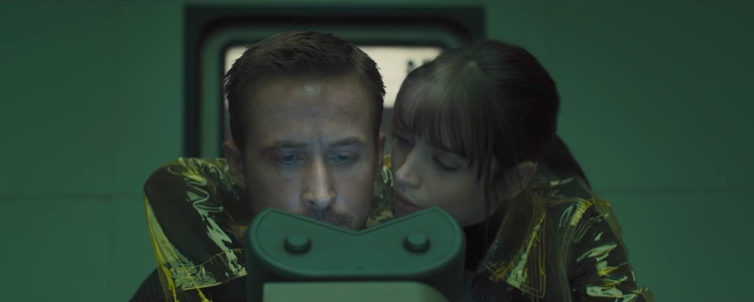The portrayal of artificial intelligence in Blade Runner 2049 takes on a nuance absent in the original film. In addition to the advanced intelligence of the replican ts — human-seeming biological machines — there is also the holographic character Joi, a logical extension of today’s digital assistants such as Apple’s Siri , Microsoft’s Cortana or Amazon’s Alexa .
copyright by theconversation.com
 Aside from these two depictions, AI is largely relegated to the background. It’s performing simple tasks such as running machines, and autonomously piloting spinners (Blade Runner’s flying cars). It’s also dynamically altering the environments that people inhabit, causing light to move with them as they walk through beautiful and brutal constructed spaces.
Aside from these two depictions, AI is largely relegated to the background. It’s performing simple tasks such as running machines, and autonomously piloting spinners (Blade Runner’s flying cars). It’s also dynamically altering the environments that people inhabit, causing light to move with them as they walk through beautiful and brutal constructed spaces.
Human vs machine
In all of these forms, the film makes a key distinction between human and artificial intelligence: Only people are capable of creativity — AI is mechanical.
As researchers interested in digital automation and expertise, we can say that Blade Runner 2049’s depiction of AI as mundane belies today’s reality and the history of the field.
Recent examples have shown computers have started to become active participants in creative work such as the field of design, collaborating with humans to shape the objects and experiences that fill our daily lives. Moreover, there is also a long history around computation and creativity that needs to be addressed. In Blade Runner 2049, actor Ryan Gosling plays police officer K who is accompanied by a holographic artificial intelligence character, Joi, played by Ana de Armas.
Generative design
The newly-emerging field known as “generative design” seeks to incorporate the computer more actively into the design process. In these kinds of computer applications, the designer uploads a “seed geometry” — akin to a keyframe reference drawing an animator might use — and then sets a series of requirements ranging from the aesthetic to the functional.
The software then searches through a series of procedurally-generated designs based on the seed geometry and surfaces those that meet the requirements. The designer can select one of these “solutions” for production or to function as the next seed geometry and the process begins again.
The Elbo chair is a recent example of a successful use of generative design that has garnered a great deal of attention. Created in the summer of 2016 by Autodesk researchers Brittany Presten and Arthur Harsuvanakit, the chair was a part of a project examining how to best incorporate generative design tools into traditional computer-aided design (CAD) software. […]
Thank you for reading this post, don't forget to subscribe to our AI NAVIGATOR!
read more – copyright by theconversation.com


The portrayal of artificial intelligence in Blade Runner 2049 takes on a nuance absent in the original film. In addition to the advanced intelligence of the replican ts — human-seeming biological machines — there is also the holographic character Joi, a logical extension of today’s digital assistants such as Apple’s Siri , Microsoft’s Cortana or Amazon’s Alexa .
copyright by theconversation.com
Human vs machine
In all of these forms, the film makes a key distinction between human and artificial intelligence: Only people are capable of creativity — AI is mechanical.
As researchers interested in digital automation and expertise, we can say that Blade Runner 2049’s depiction of AI as mundane belies today’s reality and the history of the field.
Recent examples have shown computers have started to become active participants in creative work such as the field of design, collaborating with humans to shape the objects and experiences that fill our daily lives. Moreover, there is also a long history around computation and creativity that needs to be addressed. In Blade Runner 2049, actor Ryan Gosling plays police officer K who is accompanied by a holographic artificial intelligence character, Joi, played by Ana de Armas.
Generative design
The newly-emerging field known as “generative design” seeks to incorporate the computer more actively into the design process. In these kinds of computer applications, the designer uploads a “seed geometry” — akin to a keyframe reference drawing an animator might use — and then sets a series of requirements ranging from the aesthetic to the functional.
The software then searches through a series of procedurally-generated designs based on the seed geometry and surfaces those that meet the requirements. The designer can select one of these “solutions” for production or to function as the next seed geometry and the process begins again.
The Elbo chair is a recent example of a successful use of generative design that has garnered a great deal of attention. Created in the summer of 2016 by Autodesk researchers Brittany Presten and Arthur Harsuvanakit, the chair was a part of a project examining how to best incorporate generative design tools into traditional computer-aided design (CAD) software. […]
Thank you for reading this post, don't forget to subscribe to our AI NAVIGATOR!
read more – copyright by theconversation.com
Share this: